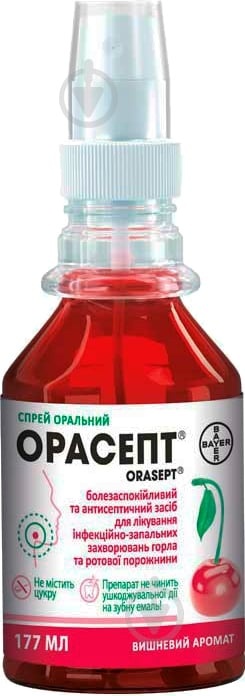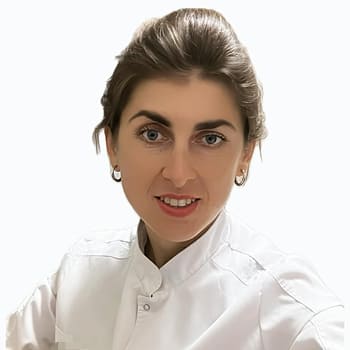

ORASEPT

Zapytaj lekarza o receptę na ORASEPT

Jak stosować ORASEPT
INSTRUCTIONS for medical use of the medicinal product CLAFEN (CLAFEN)
Composition
active substance: diclofenac; 1 g of gel contains 50 mg of diclofenac sodium; excipients: benzyl alcohol, purified water, diethylene glycol monoethyl ether, ethanol 96%, propylene glycol, hydroxyethylcellulose.
Pharmaceutical form
Gel.
Main physical and chemical properties
Colorless or slightly pink homogeneous gel.
Pharmacotherapeutic group
Means used locally for joint and muscle pain. Non-steroidal anti-inflammatory drugs for topical use. Diclofenac. ATC code M02A A15.
Pharmacological properties
Pharmacodynamics
Clafen is a non-steroidal anti-inflammatory drug for external use of the phenylacetic acid derivatives group. The drug has pronounced local anti-rheumatic, analgesic, and anti-inflammatory properties, which are due to the inhibition of prostaglandin synthesis - mediators of pain and inflammation.
In inflammation caused by injuries or rheumatic diseases, the medicinal product Clafen leads to a decrease in pain, swelling of tissues, and a reduction in the period of recovery of damaged joints, ligaments, tendons, and muscles.
Pharmacokinetics
Sodium diclofenac is slowly and partially absorbed from the skin surface. The amount of diclofenac absorbed through the skin is proportional to the area of its application and depends on both the total dose of the drug applied and the degree of skin hydration. The maximum concentration in plasma is observed after 6-9 hours. After internal administration, the maximum concentration in plasma is reached approximately after 1-2 hours. The average duration of the active substance in the systemic circulation is approximately 9 hours, which is significantly longer compared to 1-2 hours after internal administration.
Diclofenac accumulates in the skin, which serves as a reservoir, from which the substance is gradually released into the surrounding tissues. From there, diclofenac mainly enters the deeper inflamed tissues, such as joints, where it continues to act and is determined in concentrations up to 20 times higher than in plasma.
The metabolism and excretion of the drug after application to the skin are similar to those after systemic administration. Diclofenac and its metabolites are excreted mainly with urine. The total systemic plasma clearance of diclofenac is 263 ± 56 ml/min, and the terminal half-life is approximately 1-3 hours. Diclofenac is bound to plasma proteins by 99%. After rapid metabolism in the liver (hydroxylation and conjugation with glucuronic acid), two-thirds of the substance are excreted by the kidneys and one-third by the bile.
In case of renal or hepatic insufficiency, the metabolism and excretion of diclofenac from the body do not change.
Clinical characteristics
Indications
Local treatment of pain and inflammation of joints, muscles, ligaments, and tendons of rheumatic or traumatic origin.
Contraindications
Increased sensitivity to diclofenac or to other non-steroidal anti-inflammatory drugs, or to other components of the medicinal product. Presence in the anamnesis of attacks of bronchial asthma, urticaria, acute rhinitis, nasal polyps, angioedema, caused by the use of acetylsalicylic acid or other non-steroidal anti-inflammatory drugs. Third trimester of pregnancy.
Childhood.
Interaction with other medicinal products and other types of interactions
Since the systemic absorption of diclofenac due to local application of the drug is very low, the occurrence of interactions is unlikely.
Special warnings
The drug should be used with caution in combination with oral non-steroidal anti-inflammatory drugs.
The likelihood of developing systemic side effects when using diclofenac locally is small compared to the use of its oral forms, but it is not excluded when using the drug on relatively large areas of skin for a long time.
Clafen gel is recommended to be applied only to intact skin areas, avoiding contact with inflamed, damaged, or infected skin. Contact with the eyes and mucous membranes should be avoided. The drug should not be taken internally.
In case of any skin rash, treatment with the drug should be stopped. The use of an airtight occlusive dressing is not recommended, but its use under a non-occlusive dressing is allowed. In case of sprain, the affected area can be bandaged.
Do not apply to open wounds or infected skin, as well as to skin areas affected by eczema or to mucous membranes.
Due to the possibility of photosensitivity, direct sunlight and visits to the solarium should be avoided during treatment and for 2 weeks after stopping treatment.
Clafen, 5% gel, contains propylene glycol, which can cause skin irritation.
Use during pregnancy or breastfeeding
Pregnancy
Clinical data on the use of Clafen during pregnancy are absent. Even if the systemic effect is lower compared to oral administration, it is not known whether the systemic effect of Clafen achieved after local application can be harmful to the embryo/fetus. During the first and second trimesters of pregnancy, Clafen should not be used without urgent need. In case of use, the dose should be as low as possible, and the duration of treatment should be as short as possible.
During the third trimester of pregnancy, systemic administration of prostaglandin synthesis inhibitors, including Clafen, can cause cardiopulmonary and renal toxicity in the fetus. In the late stages of pregnancy, prolonged bleeding may occur in both the mother and the child, as well as a delay in labor. Therefore, Clafen is contraindicated during the last trimester of pregnancy (see section "Contraindications").
Breastfeeding
It is not known whether diclofenac is excreted in breast milk when used externally, so the use of the medicinal product Clafen during breastfeeding is allowed only if the expected benefit, in the doctor's opinion, outweighs the potential risk to the infant. If there are significant reasons for using the drug during breastfeeding, the gel should not be applied to the mammary glands or large areas of skin, and it should not be used in larger quantities or for a longer period than recommended.
Fertility
There are no available data on the effect of diclofenac on human fertility when used locally.
Ability to affect the speed of reaction when driving vehicles or other mechanisms
Does not affect.
Method of application and doses
Clafen should be applied 3-4 times a day, lightly rubbing into the skin. The amount of the drug used depends on the size of the affected area (e.g., 2-4 g of gel, which corresponds to the size of a cherry or a walnut, is sufficient for application to an area of 400-800 cm2).
After applying the drug, hands should be washed, except in cases where the area itself is being treated.
The duration of therapy depends on the nature of the disease and the effectiveness of the treatment.
The drug should not be used for more than 14 days in a row.
In case of use of the drug not according to the doctor's prescription, it is necessary to consult a doctor if the patient's condition has not improved or worsened after 7 days of treatment.
Patient over 65 years old
There are no grounds to believe that patients over 65 years old require special dose selection or may experience side effects different from other patients.
Patient with renal insufficiency
There are no grounds to believe that patients with renal insufficiency require special dose selection.
Patient with hepatic insufficiency
There are no grounds to believe that patients with hepatic insufficiency require special dose selection.
Children
Recommendations for dosing and therapeutic indications for the use of the medicinal product Clafen in children are absent.
Overdose
Overdose is unlikely due to the low absorption of diclofenac into the systemic bloodstream when applied locally. In case of accidental ingestion, it should be taken into account that 1 tube of the drug (45 g) contains an equivalent of 2250 mg of diclofenac sodium; in this case, the development of systemic side effects is possible.
In case of accidental ingestion of the drug, the stomach should be immediately emptied, and an adsorbent should be used. Symptomatic treatment and therapeutic measures used in case of overdose of non-steroidal anti-inflammatory drugs should be applied.
Side effects
Clafen is usually well tolerated. Side effects include mild temporary reactions on the skin at the site of application. In rare cases, allergic reactions may occur.
The assessment of side effects is presented by frequency of occurrence: very common (≥1/10), common (≥1/100, ≤1/10), uncommon (≥1/1000, ≤1/100), rare (≥1/10 000, ≤1/1000), very rare (<1/10 000).
Infections and invasions: very rare - pustular rashes.
From the skin: uncommon - rash, itching, redness, eczema, exanthema, erythema, burning, appearance of edema and vesicles, papules, pustules, peeling, and dryness of the skin, dermatitis (including contact dermatitis); rare - bullous dermatitis; very rare - photosensitivity reactions, generalized skin rashes, skin burning sensation.
From the immune system: very rare - hypersensitivity reactions (including urticaria), angioedema of the face, dyspnea.
From the respiratory system: very rare - bronchial asthma.
From the digestive system, side effects occur very rarely after local application of drugs containing diclofenac.
When using the gel in high doses or applying it to large areas of skin, the possibility of systemic side effects cannot be excluded, as well as hypersensitivity reactions in the form of angioedema, dyspnea.
Shelf life
3 years.
Storage conditions
Store in the original packaging at a temperature not exceeding 25 °C.
Store in a place inaccessible to children.
Packaging
45 g of gel in a tube; 1 tube in a cardboard box.
Release category
Without a prescription.
Manufacturer
ANTIBIOTICE SA
ANTIBIOTICE SA
Location of the manufacturer and address of the place of its activity.
Valea Lupului Street 1, Iasi 707410, Romania
1, Valea Lupului Street, 707410, Iasi, Romania
- Kraj rejestracji
- Substancja czynna
- Wymaga receptyNie
- Producent
- Te informacje mają charakter wyłącznie poglądowy i nie stanowią porady medycznej. Przed zastosowaniem jakiegokolwiek leku zawsze skonsultuj się z lekarzem. Oladoctor nie ponosi odpowiedzialności za decyzje medyczne podjęte na podstawie tych treści.
- Zamienniki ORASEPTPostać farmaceutyczna: solution, 1.4% 120mlSubstancja czynna: phenolProducent: Фармасайнс Інк.Bez receptyPostać farmaceutyczna: lozenges, 12 lozenges in a blisterSubstancja czynna: variousProducent: Др. Тайсс Натурварен ГмбХBez receptyPostać farmaceutyczna: lozenges, 12 lozenges in a blisterSubstancja czynna: variousProducent: Др. Тайсс Натурварен ГмбХBez recepty
Odpowiedniki ORASEPT w innych krajach
Najlepsze odpowiedniki z tą samą substancją czynną i działaniem terapeutycznym.
Odpowiednik ORASEPT – Polska
Odpowiednik ORASEPT – Hiszpania
Lekarze online w sprawie ORASEPT
Konsultacja w sprawie dawkowania, działań niepożądanych, interakcji, przeciwwskazań i odnowienia recepty na ORASEPT – decyzja należy do lekarza, zgodnie z lokalnymi przepisami.






